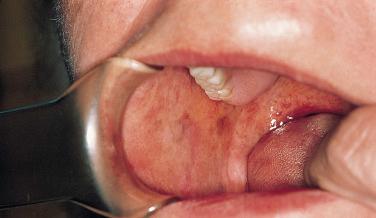Physical Address
304 North Cardinal St.
Dorchester Center, MA 02124
Classic signs of excess cortisol (Cushing’s) include moon facies, striae, atrophy, and acne.
Cortisol deficiency (Addison’s) presents with hyperpigmentation of the skin, nails, and mucous membranes.
Excess androgens, as seen in polycystic ovary syndrome and congenital adrenal hyperplasia, cause hirsutism, acne, male-pattern alopecia, and virilization.
Androgen insensitivity (testicular feminization) leads to ambiguous genitalia, sparse sexual hair development, and an absence of acne and male-pattern alopecia.
Acromegaly due to excess growth hormone and insulin-like growth factor 1 causes characteristic frontal bossing and prognathia, enlarged nose, tongue, lips, and hands.
Hypopituitarism can manifest with thin skin, scant body hair, and pale complexion.
Hormones of the steroid family (glucocorticoids, androgens and other sex steroids, and mineralocorticoids) are critical in the control of homeostasis and cell differentiation. These hormones are produced by the adrenal gland and gonads, and are regulated by pituitary secretions. They control cell growth, differentiation, and metabolism by binding to intracellular receptors that act directly at the DNA level to produce changes in gene expression.
Hypercortisolism is most commonly the result of exogenous administration of glucocorticoids, but similar findings occur in patients with endogenous hypercortisolism, e.g., excess pituitary adrenocorticotropic hormone (ACTH) production (Cushing disease), ectopic ACTH secretion, or glucocorticoid-producing adrenal tumors. These findings may be dramatic or subtle. Systemically, they include hypertension, proximal muscle weakness/myopathy, diabetes, obesity, osteopenia and osteoporosis, and psychiatric disturbances. The association of these features with characteristic cutaneous and physical changes should raise the possibility of Cushing syndrome.
Cutaneous findings in hypercortisolism include cutaneous atrophy, striae, purpura, telangiectasias, and acne. Cutaneous atrophy is caused by a reduction in both epidermal and dermal components. There is thinning of the epidermis, and collagen synthesis is reduced. There is also loss of elastic fibers and dermal mucopolysaccharides. A weakened dermis and obesity result in the development of prominent striae ( Fig. 27-1 ). The skin is injured easily by minor trauma. Purpura, skin tears, and ulcerations result; these, in turn, heal slowly due to the inhibiting effects of cortisol on wound healing.

Subcutaneous fat deposition over the face and trunk contributes to the characteristic moon facies and body habitus—buffalo hump, supraclavicular fat pad, and central adiposity. Erythrocytosis, telangiectasias, and cutaneous atrophy also contribute to the characteristic facial appearance, which is notably round and plethoric. Steroid acne may also occur. This disorder is distinguished from typical acne vulgaris by the absence of a comedonal component as well as by the monomorphic appearance of its red papules and pustules, which are in a uniform stage of development. The usual distribution is on the upper trunk, shoulders, and arms, with relative sparing of the face. Patients with hypercortisolism are also predisposed to the development of chronic fungal infections of the skin (tinea versicolor, dermatophytosis, and candidal infections). When hypercortisolism is caused by increased ACTH production, hyperpigmentation may occur, as in adrenal insufficiency.
Cortisol levels can be increased in several disorders other than Cushing syndrome. This scenario, a kind of physiologic hypercortisolism, is known as pseudo-Cushing syndrome. Possible causes include physiologic stress, such as is seen in the setting of severe infection; significant obesity or polycystic ovary syndrome; psychological stress, such as severe major depressive disorder; and, in rare cases, chronic alcoholism. Patients with pseudo-Cushing syndrome seldom display the cutaneous findings associated with true Cushing’s. Laboratory abnormalities observed in hypercortisolism include hyperglycemia and hypokalemia. After excluding exogeneous glucocorticoid use, those with clinical features of Cushing syndrome should undergo initial screening using 24-hour urine free cortisol, late night salivary cortisol, or low-dose dexamethasone suppression test. The evidence-based Endocrine Society Guidelines (2008) recommend at least two of these tests be unequivocally abnormal to establish the diagnosis. Because of limited sensitivity and specificity, these tests should be performed more than once, and their results should be concordant.
After the presence of hypercortisolism is confirmed, additional testing must be performed to determine the cause. Most cases of endogenous hypercortisolism are the result of excessive secretion of ACTH by a pituitary tumor. Other causes include adrenal tumors (which are ACTH-independent) and ACTH production from nonpituitary tumors, the most common of which are oat cell carcinoma of the lung, carcinoid, gastrinoma, malignant thymoma, pheochromocytoma, and medullary carcinoma of the thyroid. The treatment of hypercortisolism depends on the detection and correction of the underlying cause, such as surgical resection of a causative tumor.
Adrenal insufficiency may result from a number of processes that cause extensive destruction or dysfunction of the adrenal cortices. Prolonged administration of synthetic glucocorticoids with subsequent discontinuation is by far the most common cause of adrenal insufficiency. Other major causes include autoimmune adrenalitis (more common in women), infections (primarily tuberculosis and deep fungal infections), and metastatic disease. Less common causes include drugs and hemorrhage. The systemic antifungal medication ketoconazole inhibits steroidogenesis but only rarely causes clinical hypocortisolism. Other medications that inhibit cortisol biosynthesis include the antiepileptic drug aminoglutethimide, the anesthetic sedative drug etomidate, and the antiparasitic drug suramin.
The clinical manifestations of Addison’s are diverse. Constitutional symptoms include malaise, reduced energy, weight loss, and a feeling of ill health. Other systemic manifestations are hypotension, weakness, fatigue, gastrointestinal symptoms (anorexia, nausea, and abdominal pain), and psychiatric symptoms. Adrenal crisis (acute adrenal insufficiency) may result in life-threatening hypotension and shock.
The primary dermatologic manifestation is hyperpigmentation of the skin and mucous membranes ( Fig. 27-2 ). The hyperpigmentation of adrenal insufficiency is the most characteristic physical finding of the disease and may precede other symptoms by months or years. Skin darkening is induced by high levels of ACTH and melanocyte-stimulating hormone, which share the prohormone pro-opiomelanocortin in common. For this reason, hyperpigmentation does not occur in those with pituitary failure but is, rather, limited to those with primary adrenal failure. Because adrenal insufficiency often has an insidious onset, the hyperpigmentation may go unnoticed by the patient. Commonly involved areas include those which are sun-exposed; those exposed to friction or pressure such as the knuckles, elbows, and knees; scars; and naturally hyperpigmented sites such as the axillae, perineum, and nipples. Darkening of the palmar creases is considered nearly specific for adrenal insufficiency in light-skinned patients. Pigmentation of the tongue, lips, and buccal mucosa is another useful sign. The hair may become darker, and pigmented longitudinal bands may develop on the nails. New nevi can appear, and old nevi darken.

Adrenal insufficiency is associated with other skin manifestations as a part of polyglandular autoimmune syndrome type I (chronic mucocutaneous candidiasis) and type II (vitiligo). A rare manifestation of adrenal insufficiency is fibrosis and calcification of the ear cartilage.
The laboratory abnormalities seen in adrenal insufficiency include hyponatremia and hyperkalemia. Screening for adrenal insufficiency includes two tests: basal plasma ACTH level and cortisol level 30 to 60 minutes following ACTH (cosyntropin) stimulation test. Primary adrenal insufficiency manifests with high basal ACTH combined with a blunted cortisol response to the ACTH stimulation test. Low cortisol and low basal ACTH levels suggest either secondary (i.e., pituitary) or tertiary (i.e., hypothalamic) adrenal insufficiency. In this instance, a corticotropin-releasing hormone stimulation test is necessary to distinguish between the two etiologies. After the diagnosis of hypocortisolemia is determined, the cause of adrenal failure must be found.
The treatment of adrenal insufficiency is long-term replacement of glucocorticoids. Prednisone and dexamethasone have replaced shorter-acting agents such as cortisone or hydrocortisone because the longer duration of action provides a smoother physiologic effect. Mineralocorticoid replacement can be achieved with fludrocortisone. In times of physiologic stress induced by illness or surgery, glucocorticoid replacement must be increased to avoid adrenal crisis.
Pheochromocytoma is a catecholamine-producing tumor arising from chromaffin cells of the sympathetic nervous system. The majority of pheochromocytomas develop in the medulla of one or both adrenal glands. Other sites of origin include para-aortic sympathetic ganglia, the walls of the urinary bladder, the chest, and, extremely rarely, sympathetic tissue associated with intracranial branches of the vagus nerve. Some inherited disorders predispose to pheochromocytomas, including neurofibromatosis, von Hippel–Lindau syndrome, and multiple endocrine neoplasia type 2 (or Sipple syndrome). More than 90% of the tumors are benign. They occur most frequently during the fourth and fifth decades of life.
The most distinctive clinical feature of pheochromocytoma is hypertension, although it accounts for less than 0.1% of patients with diastolic hypertension. The hypertension is usually paroxysmal and occurs in association with headaches, palpitations, sweating, and a feeling of apprehension. Symptoms can be reproduced experimentally by the injection of norepinephrine (noradrenaline) and epinephrine (adrenaline). These episodes may occur at weekly intervals or as frequently as 20 times a day. They may be precipitated by emotional situations, eating, exercise, and by activities that compress the tumor, such as bending. The only significant cutaneous manifestation of pheochromocytoma is flushing, which appears to occur primarily when the tumor secretes larger amounts of epinephrine than norepinephrine. The flushing occurs paroxysmally and is most prominent on the face, chest, and upper extremities. When pheochromocytomas occur as part of a genetic syndrome, cutaneous manifestations of that syndrome may also be apparent. In some patients with hypertension, for example, recognition of café-au-lait macules of neurofibromatosis may lead to the appropriate diagnosis.
The diagnosis of pheochromocytoma can be established by assaying levels of catecholamines and their metabolites in the plasma or urine (fractionated catecholamines and metanephrines), especially during paroxysmal attacks. In patients in whom the episodes are very brief, establishing the diagnosis is much more challenging, and, occasionally, induction of attacks with intravenous glucagon or histamine is performed. Treatment involves the use of adrenergic antagonists, beginning with alpha blockers such as phentolamine and phenoxybenzamine, and surgical removal of the tumors.
Become a Clinical Tree membership for Full access and enjoy Unlimited articles
If you are a member. Log in here